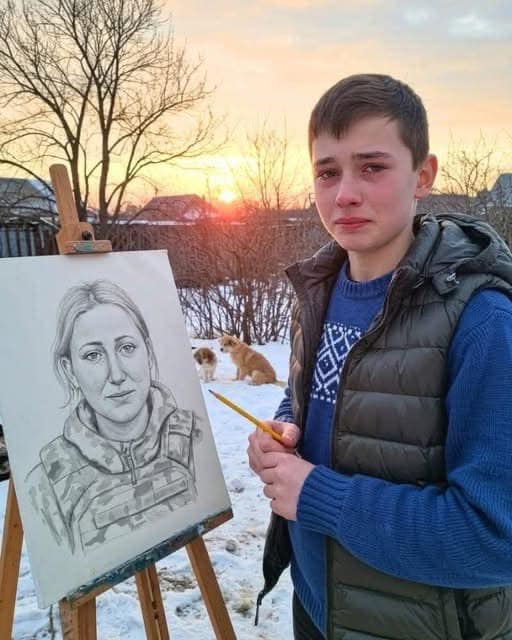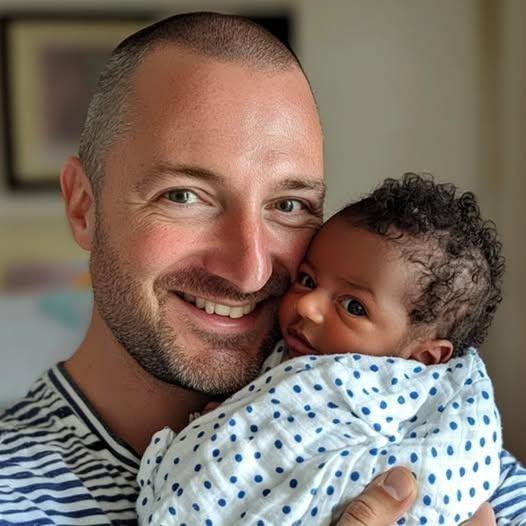This boy painted a portrait of his late mother
Certainly! Here’s a longer version of the story, about 700 words:
The Unseen Portrait
Ethan sat in the dim light of his bedroom, the world outside oblivious to the quiet storm raging within him. His fingers trembled slightly as they gripped the brush, dipping it into the deep red of the paint. The canvas before him remained blank, as it had for days. But now, the time had come. His brush slowly began to dance across the canvas, pulling the image from the depths of his mind—the face of his mother, her soft smile and warm eyes, locked forever in his memory.
She had passed away when he was just fourteen. His mother, the one person who had always been there to listen, to understand, was now gone. The world, however, moved on. Time passed in its relentless march, and Ethan found himself lost, drifting without her steady presence. Grief had a way of isolating him, making the world seem so much colder. His father, too overcome by his own sorrow, became distant, locking himself in his own grief. His friends, well-meaning but unaware of the weight Ethan carried, had long since moved on. They had told him to be strong, to stop dwelling on the past, as if the pain of losing someone you loved could simply vanish with the passage of time.
But for Ethan, that pain didn’t fade. It lived inside him, and he couldn’t just leave it behind. He found solace in art, a way to pour out his emotions that words couldn’t capture. The portrait he was painting was more than just a picture—it was a lifeline, a way to hold on to his mother when everything else was slipping through his fingers.
His hand moved across the canvas, each stroke bringing him closer to capturing her likeness, her spirit. The soft curves of her face began to emerge, the curve of her cheek, the warmth in her eyes that had always made him feel safe, loved, and understood. Ethan had always been her little boy, and in the quiet moments of their time together, he felt like the most important person in the world. And now, as he painted her, he realized that he would never again hear her voice or feel her arms around him. It was a harsh truth, one that made his chest tighten with grief. But painting her was the only way he could keep her alive, at least in his heart.
The days passed, and the painting began to take shape. It was far from perfect. Some parts of it felt unfinished, others too bold, yet in every inch of the canvas, he could see her—his mother, the woman who had shaped him into who he was. It was messy, imperfect, just like his grief. But that was part of the process, wasn’t it? Grief didn’t look pretty. It didn’t conform to expectations. It was raw and jagged, and it didn’t care for neatness or order.
When the painting was finished, Ethan sat back, staring at it. His heart ached, a heavy weight pressing down on him. But there was also something else—something softer. A quiet peace, perhaps. His mother was with him in the colors and lines. She was still there, in the art he had created. No one could take that from him. He wasn’t ready to let her go, and this painting was the closest he could get to holding on to her.
With trembling hands, he walked downstairs, the painting under his arm. He found his father sitting in his usual spot, staring blankly at the television. Ethan cleared his throat, but his father didn’t look up. He hesitated, then held out the portrait.
“I… I finished it,” he said softly, his voice shaking with the vulnerability he rarely allowed himself to show.
His father looked at the painting, his expression unreadable. For a moment, he was silent, and Ethan’s heart pounded in his chest. Finally, his father spoke, his voice distant.
“It’s… it’s nice, I guess,” he said, his words flat. He didn’t seem to see the depth of it. He didn’t see the rawness behind each brushstroke, the grief and love that poured into every inch of the canvas. He just saw a picture. Just another thing to get through. Just another phase.
Ethan felt his chest tighten. The sting of rejection, of not being understood, burned deep. But as he stood there, waiting for something—anything—from his father, he realized that maybe no one would understand. Maybe no one would see the portrait the way he did, as more than just a picture. And in that moment, a quiet resignation settled over him. He couldn’t control how others saw his art or his grief. But it didn’t matter. This painting was for him.
Later, when his friends came by, Ethan showed them the portrait. Their reactions were cold, dismissive even. One of them glanced at it briefly and shrugged. “It’s just a painting, man. You’ll be fine. Don’t dwell on this stuff.”
No one supported him. No one understood. It stung, but Ethan didn’t let it break him. The portrait was his. He had painted his mother’s face not for validation or approval, but as a testament to the love he still carried for her. Maybe the world couldn’t see it, but that didn’t diminish its worth. His grief was real. His love was real. And in the painting, his mother was still there, as vivid as ever.
And so, with the world uninterested or unaware, Ethan kept the portrait close, a quiet, personal reminder that some things—some loves—are too deep to be forgotten, even when no one else can see them.
This version dives deeper into Ethan’s emotional journey and the lack of support he experiences from those around him. It explores the themes of grief, art, and the struggle to find connection in a world that often doesn’t understand.






